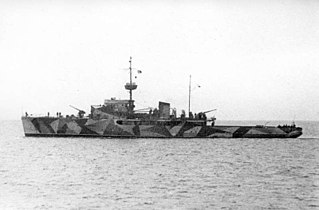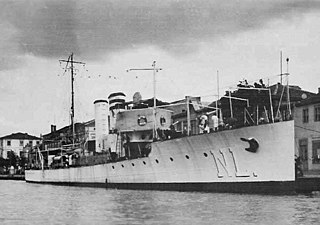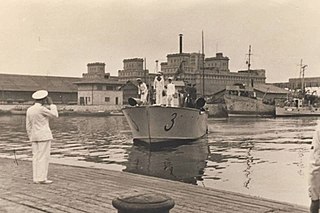
Horia Macellariu was a Romanian rear admiral, commander of the Royal Romanian Navy's Black Sea Fleet during the Second World War.

The Vifor class was a group of four destroyers ordered by Romania in 1913 and built in Italy during the First World War. The four ships were however requisitioned by Italy in 1915 and rearmed as scout cruisers (esploratori), subsequently seeing service in World War I. Two were re-purchased by Romania in 1920 and saw service in World War II. The other two were eventually transferred by Italy to the Spanish Nationalists and saw service during the Spanish Civil War.

Operation München was the Romanian codename of a joint German-Romanian offensive during the German invasion of the Soviet Union in World War II, with the primary objective of recapturing Bessarabia, Northern Bukovina and the Hertsa region, ceded by Romania to the Soviet Union a year before. The operation concluded successfully after 24 days of fighting. Axis formations involved included the Romanian Third and the Fourth Armies and the German Eleventh Army. The invasion was followed by a genocide against the Jewish population of Bessarabia.

NMS Amiral Murgescu was a minelayer and convoy escort of the Romanian Navy, the first sea-going warship built in Romania and the largest Romanian-built warship of World War II. She laid numerous minefields, from the Bulgarian port of Burgas to the Crimean port of Sevastopol, which inflicted significant losses to the Soviet Black Sea Fleet. She also carried out numerous convoy escort missions and took part in the Axis evacuation of the Crimea in May 1944. Due to her success in combat, she was decorated twice by May 1944. She was captured by the Soviet Union in September 1944 and served until 1988, when she was scrapped.

NMS Marsuinul was a submarine of the Romanian Navy, one of the few warships built in Romania during the Second World War. She was the largest Romanian-built submarine and the most powerful and modern Axis submarine in the Black Sea.
The Romanian Navy during World War II was the main Axis naval force in the Black Sea campaigns and fought against the Soviet Union's Black Sea Fleet from 1941 to 1944. Operations consisted mainly of mine warfare, but there were also escort missions and localized naval engagements. The largest naval action fought by the Romanian Navy was the 26 June 1941 Raid on Constanța, and its most extensive operation was the 1944 evacuation of the Crimea.

The action of 9 July 1941 was a naval engagement between the Soviet and Romanian navies during World War II, taking place near the Romanian port-city of Mangalia.

NMS Mihail Kogălniceanu was a monitor of the Romanian Navy. She saw service in both world wars, being the most successful vessel in her class of four ships. Like her three sisters, she was initially built as a river monitor, but in early 1918, she was converted to a sea-going monitor. During the Second Balkan War, she supported the Romanian crossing of the Danube into Bulgaria. During World War I, she carried out numerous bombardments against the Central Powers forces advancing along the shore of the Danube and carried out the last action of the Romanian Navy before the 11 November 1918 armistice. She later fought successfully against Bolshevik naval forces during the early months of the Russian Civil War, helping secure the Budjak region. During the interwar period, she contributed to the suppression of the Tatarbunary Uprising and was rearmed with longer main guns towards the end of the 1930s. During World War II, she fought several engagements against the Soviet Navy in the first month of the Eastern Front, but was ultimately sunk by Soviet aircraft shortly after Romania ceased hostilities against the Soviet Union, on 24 August 1944.
During the Second World War, the Royal Romanian Navy operated a total of 9 submarines: three fleet submarines and six midget submarines. These vessels fought on the Axis side during the war. Only two of them survived the war and continued to serve in the Romanian Navy until the 1960s.

NMS Constanța was a submarine tender of the Romanian Navy. She was commissioned in 1931 and fought in the Second World War, being scrapped in 1977.

NMS Viscolul was the most successful and the longest-serving motor torpedo boat of the Romanian Navy during the Second World War. She supported the Siege of Odessa and took part in the action of 9 July 1941.

NMS Sublocotenent Ghiculescu was a specialized ASW gunboat of the Romanian Navy. Initially built as a French warship in late World War I, she was purchased by Romania in 1920 and fought during World War II, sinking two submarines and one motor torpedo boat. After 1 year of Soviet service, she was returned to Romania and served as a survey vessel until 2002.

The Soviet Black Sea Fleet during the first years of the Black Sea campaigns (1941–44) conducted raiding operations along the Western coast of the Black Sea aimed to disrupt Axis communications and supplies by sea.

NMS Năluca was a torpedo boat of the Royal Romanian Navy. She was commissioned in 1920, after initially serving as Tb 82 F in the Austro-Hungarian Navy during World War I. She and six more sister ships were awarded to Romania as reparations after the war ended.

The action of 26 June 1941 consisted in an engagement between the navies of the Soviet Union and the Kingdom of Romania, taking place on the Chilia branch of the Danube Delta, near the commune of Ceatalchioi. The action resulted in a Romanian victory and the withdrawal of the Soviet vessels, one of them being damaged and later captured.
The Number 31 class was a group of four small multi-purpose motor launches of the Royal Romanian Navy. They served on the Danube and in the Black Sea aboard the escort minelayer Amiral Murgescu.

NMS Rechinul was a submarine of the Romanian Navy, one of the few warships built in Romania during World War II and used during the war. She was made at the Galați shipyard in 1938, launched in 1941, and completed in 1942. Rechinul took part in the evacuation of the Crimea and later performed the longest mission in Romanian submarine history, starting on 15 June 1944 and lasting 45 days.
The Romanian Danube Flotilla is the oldest extant naval force on the Danube, dating since 1860, when the Romanian Navy was founded. It saw service during most of the wars involving Romania, and was the most powerful river naval force in the world during the Interwar period.













